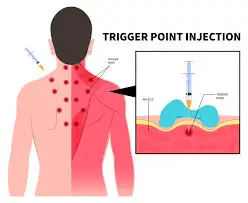Trigger Point Injections
What is a Trigger Point Injections?
Trigger point injections are a specialized medical treatment aimed at relieving pain and discomfort associated with muscle knots, commonly known as trigger points. These are hyperirritable spots within a muscle that can cause localized pain or refer pain to other areas of the body. Trigger point injections involve the insertion of a small needle directly into the trigger point, often containing an anesthetic, saline, or corticosteroid.
This procedure is typically performed by a healthcare professional, such as a physician or a trained physiotherapist, and is used to alleviate pain, improve range of motion, and enhance overall function for patients suffering from chronic muscle pain conditions, such as myofascial pain syndrome.
Anatomy and Physiology
The pathophysiology of trigger points is believed to be associated with abnormal motor end-plates in muscles where nociceptive and motor neurons coexist, as well as heightened central sensitization in the spinal cord. EMG research has revealed spontaneous electrical activity at trigger locations, indicating the creation of abnormal action potentials.
Histological evidence from muscle biopsies supporting the idea of continuous sarcoplasmic reticulum calcium release consequent to brain activation and action potential production is supported by the evidence of hyper-contracture of the muscles. Individuals may feel localized pain, which can cause tense muscles and a reduction in the affected tissue’s range of motion.
What are trigger point injections used for?
Trigger points can bring on certain kinds of pain or problems. For example, migraine headaches may be brought on by trigger points that impact your trapezius muscle. Piriformis syndrome, which occurs when the piriformis muscle presses against your sciatic nerve, can be brought on by a trigger point that affects the piriformis muscle, a muscle in your buttocks. It makes your buttocks hurt and sends numbness down the back of your leg.
Equipment
The following materials can be used for trigger point injections:
- 27–30 gauge For dry needling procedures, use an acupuncture needle or a 1.5-inch needle.
- 5, 10, or 3 mL syringe, Generally non-sterile gloves
- Think about adding 5% sodium bicarbonate as a buffer to lessen pain.
- Take into account different prolotherapy solutions such as sterile saline or D5W.
- An optional topical anesthetic spray, such as ethyl chloride
- Skin-cleaning products like alcohol pads or 2% chlorhexidine
- Blood pressure monitor and pulse oximeter
Procedure Details
What happens during a trigger point injection procedure?
What to anticipate from a trigger point injection operation is as follows:
Using an alcohol pad, your healthcare professional will clean the damaged region of your skin. Your healthcare professional could apply a skin marker to the trigger site.
A thin needle in a syringe will be inserted into the trigger point, and they will then rhythmically continue needling the area by putting and taking out the needle without totally taking it out of your skin or muscle.
How painful is a trigger point injection?
When your healthcare practitioner inserts the needle and medication, you can experience a burning and painful feeling. You can experience a momentary increase in pain as the needle tip comes into contact with the trigger site. This pain, though it may be unpleasant, indicates that the needle is in the right place.
Risks / Benefits
What are the benefits of trigger point injections?
Trigger point injections provide patients with a safe, flexible, and efficient way to manage chronic pain thanks to several advantages.
Pain Relief
The capacity of trigger point injections to successfully lessen a patient’s pain is among its most noteworthy advantages.
To regain their capacity to lead a normal, healthy lifestyle, patients suffering from pain resulting from muscle injuries, poor posture, torn muscles, improper diet and exercise regimen, etc., can benefit from trigger point injections.
Pain mostly radiates to another area of the body, leading to the pain in this area. Injections at trigger points assist in reducing pain and suffering all over the body, not only at the site of the injection.
Low Risk
Injections at trigger points are secure and efficient. Any form of treatment has the potential to have side effects, however, trigger point injection side effects are extremely uncommon. Soreness or pain at the injection site is one of the most frequent adverse effects that can happen.
In addition, since trigger point injections are a nonsurgical treatment, you won’t need to be concerned about any significant incisions leading to adverse effects (such as pain following the surgery, an increased risk of infection, etc.).
As a result, the treatment’s minimally invasive approach permits efficient pain relief without carrying a significant risk of negative side effects.
Shorter Recovery Period
Injections of trigger points are a nonsurgical, minimally invasive treatment that doesn’t involve any cuts. Consequently, there must be no recovery period after treatment for patients to return home right away and carry on with their regular activities, although with less chronic pain and suffering, following trigger point injections.
Injectable trigger points can relieve pain instantly, allowing you to experience the benefits of the injections immediately. As was previously said, adverse effects are uncommon and, if they do occur, are often mild and pass quickly.
Trigger point injections can bring you the pain relief you’ve been seeking without requiring you to take time off from work or other responsibilities in your life. Stop suffering from pain and start feeling better quickly with trigger point injections.
Versatile
In addition to being adaptable, trigger point injections can be utilized to treat various ailments. Trigger point injections can help with a variety of conditions, including tension headaches, myofascial pain syndrome, fibromyalgia, neck pain, and sports-related injuries.
Can Be Used With Other Treatment Options
Trigger point injections have the advantage of being able to be used in addition to other forms of treatment to assist in alleviating pain. To further lessen the pain, you can, for example, undergo trigger point injections in addition to performing physical therapy exercises.
Trigger point pain is frequently brought on by incorrect posture or inactivity, which increases the chance of tearing a muscle, having persistently bad form, etc. Therefore, you can further experience benefits in your long-term pain by taking care of such concerns at the outset.
For example, injections can assist relieve pain if you have trigger point pain brought on by poor posture.
In between treatments, physical therapy exercises can be combined with injections to help you correct your form and permanently correct the posture that was initially causing you pain.
Short Treatment Time
Depending on how many injections you need, a trigger point injection appointment might take anywhere from 15 to 30 minutes to perform.
As a result, they are a quick and simple alternative to surgery, which can take several hours, not to mention the considerable amount of recovery time required afterward. Trigger point injections don’t require surgery, so getting treated and going about your day with less pain can happen quickly.
Nonsurgical Treatment
Not to mention, trigger point injections are a non-surgical approach to treatment. Put another way, because this procedure doesn’t require any incisions, patients won’t have to worry about scarring.
Similarly, surgical procedures might be frightening and discourage individuals from seeking pain relief, even if they might be required in some circumstances based on their particular situation.
Thus, scheduling trigger point injections, which take approximately 30 minutes to complete, is less stressful than scheduling back surgery, which might take hours and need more recovery time for the patient.
In general, trigger point injections offer a low-risk, secure method of pain relief. Since this therapy doesn’t include surgery, it may be completed quickly—in less than 30 minutes—and doesn’t require any recovery time.
Similarly, the effects of alleviating pain happen right away. Trigger point injections provide patients with immediate access to fast-acting pain relief, allowing them to resume their regular lifestyles with less pain and stress.
Trigger point injections are not at all laborious or time-consuming, so don’t wait to get treatment for your trigger point pain symptoms if you’ve been putting it off out of concern.
With trigger point injections, you can get pain relief without spending a lot of time getting it and recovering from it. This allows people to quickly and effectively manage their pain sensations while still leading active lives.
Your quality of life might be severely decreased by trigger point pain. Consider obtaining trigger point injections to lessen your pain instead of living your life around it. To locate a skilled group of pain specialists nearby and begin your journey to a better, healthier life, just search for “trigger point injections near me.”
A customized treatment plan that is aimed at safely and successfully controlling your pain can be developed with the assistance of our team of highly skilled pain specialists. To give patients the precise assistance and attention they need to effectively control their pain symptoms, we also provide a range of alternative pain management therapies.
When To Call the Doctor
When should I see my healthcare provider?
Get in touch with your healthcare provider if you’ve had a trigger point injection and you’re showing symptoms of infection, such as a fever or warmth where the injection was given.
FAQ
What to expect after trigger point injections?
You can leave the clinic as soon as your trigger point injections are finished.
A patient may have modest side effects, like some soreness in the treated location, but these will go away on their own in a few hours or days.
Are there any trigger point injection side effects?
Although they are rare, you should be aware that after having trigger point injections, some negative effects could happen.
Among the adverse effects of trigger point injections are: • Pain at the injection location
Swelling, exhaustion, dizziness, and bleeding
What is a trigger point injection?
Injections of trigger points are an effective treatment method for treating myofascial trigger points, particularly in symptomatic individuals. Using a multimodal approach to pain management is essential to giving patients safe and satisfying outcomes.
How long do trigger point injections last?
A month or so may pass between episodes of pain. It can take repeated injections to provide long-term pain relief.
What should I avoid after trigger point injections?
However, you should stay away from vigorous exercise during the initial days. After the surgery, most patients are recommended to rest for a day or two so that the drug has time to take effect.
How much do trigger point injections cost?
Procedure Specifics
A trigger point/tendon injection (in-office) costs $190 on MDsave. Without insurance or with a high deductible health plan, consumers can shop around, compare costs, and save money.
How many trigger point injections do you need?
For the best pain relief, most doctors advise getting one injection every eight weeks for six months. How frequently are trigger point injections necessary?
Are trigger point injections successful?
Advantages of Injections for Trigger Points
Injectable trigger points are incredibly beneficial and effective, providing immediate pain relief among many other advantages. minimally harmful and low in negative effects. little noticeable and requiring almost no recovery time.
What kind of doctor does trigger point injections?
Different kinds of doctors can perform trigger point injections at different doctor’s offices. This treatment is typically administered by a rheumatologist, pain management specialist, rehabilitation specialist, or general practice physician.
Who should not get trigger point injections?
Individuals with hemorrhagic syndrome, allergy to local anesthetics, use of anticoagulants, or mental disturbances should not receive trigger point injections.
References
- Hammi, C., Schroeder, J. D., & Yeung, B. (2023, July 24). Trigger Point Injection. StatPearls – NCBI Bookshelf. https://www.ncbi.nlm.nih.gov/books/NBK542196/
- Gameti, D. (2024, January 11). Trigger Point Injection – Mobile Physiotherapy Clinic. Mobile Physiotherapy Clinic. https://mobilephysiotherapyclinic.in/trigger-point-injection/
- R, S. (2024, June 5). Top 7 Benefits of Trigger Point Injections. Pain & Spine Specialists Maryland and Pennsylvania. https://painandspinespecialists.com/top-7-benefits-of-trigger-point-injections/






